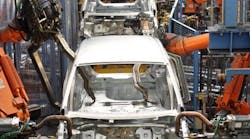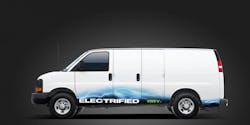The latest example comes from a pending alliance between Ford Motor Co. and General Motors to develop more fuel efficient transmissions, according to industry analyst firm ND-Automotive.
The combined size of Ford and GM's supply base would enable deep economies of scale and eliminate significant traditional overlap, allowing the pair to feasibly pursue fuel-efficient technologies with reasonable expenditure, added David Petrovski, a powertrain analyst with global consulting firm IHS Automotive.
Yet new powertrains are but the tip of the fuel efficiency iceberg, both firms noted. For example, GM recently contributed $5 million to the new National Tire Research Center in Halifax, VA, which uses tire performance machinery to recreate real-world driving events and thus craft tire designs to improve light vehicle fuel efficiency by up to 7%.
In 2014, according to ND-Automotive, Ford aims to come out with a new truck that has a largely aluminum body and is 700 pounds lighter – a development that, in the firm’s words, promises to “raise the bar on fuel economy” yet another big notch.
But such research and development efforts aren’t just occurring among the “big guys” in the vehicle OEM. For example, specialty manufacturer VIA Motors showed off the cargo van version of its unique 650-volt extended range electric vehicle (EREV) at the North American International Auto Show (NAIAS) this week; a vehicle developed in collaboration with Verizon to achieve 100 miles per gallon that’s now going to be field tested in New Jersey and New York.
“Our collaboration focused on developing a more environmentally friendly cargo van, as cargo vans are widely used by large U.S. fleets and account for more than 30% of our fleet,” noted Ken Jack, vice president-fleet for Verizon. “Electrifying these work vehicles could have a significant impact on a nationwide reduction in fuel consumption and carbon dioxide (CO2) emissions."
He added that because the average total miles per day traveled by Verizon's fleet is low, the company expects the new vans to operate entirely under electric power most days; and by doing so would annually reduce CO2emissions by approximately 2.4 metric tons and reduce petroleum fuel consumption by about 750 gallons yearly.
It’s interesting to note that VIA's exportable power system option can provide 15 kilowatts of continuous 110-volt or 220-volt power for emergency or job-site application; something Verizon’s Jack said can come in handy during emergency operations, such as the recovery work conducted in the wake of Hurricane Sandy.
VIA is also working with Pacific Gas and Electric Company (PG&E) to test its EREV models, including not only the electrified cargo van but a sport utility vehicle (SUV) and VTRUX pickup.
Indeed, back in 2008, PG&E partnered with VIA to develop its EREV VTRUX pickup, which it unveiled at the 2012 NAIAS show. Again, by driving primarily on electricity, those vehicles can more than double their fuel economy while achieving zero emissions on 50% of the miles driven on typical fleet routes.
It just goes to show that all sorts of efforts are being made to improve light vehicle fuel economy – and we’re not even close to done in terms of what’ll be deployed next to keep driving fuel efficiency higher and higher.





